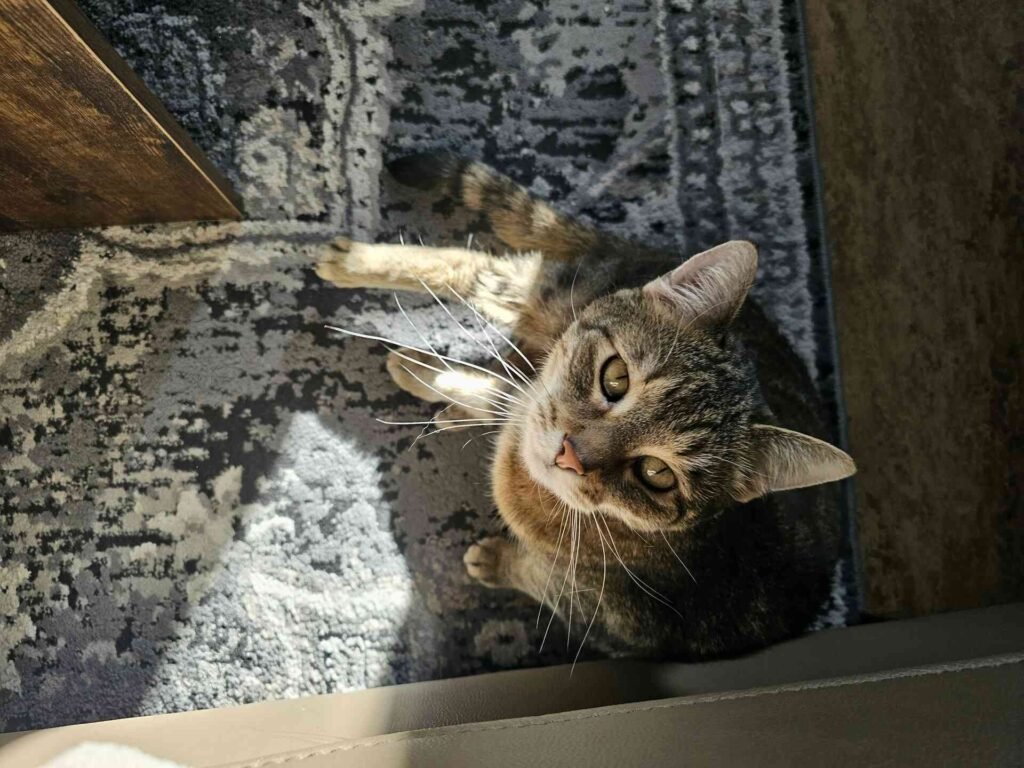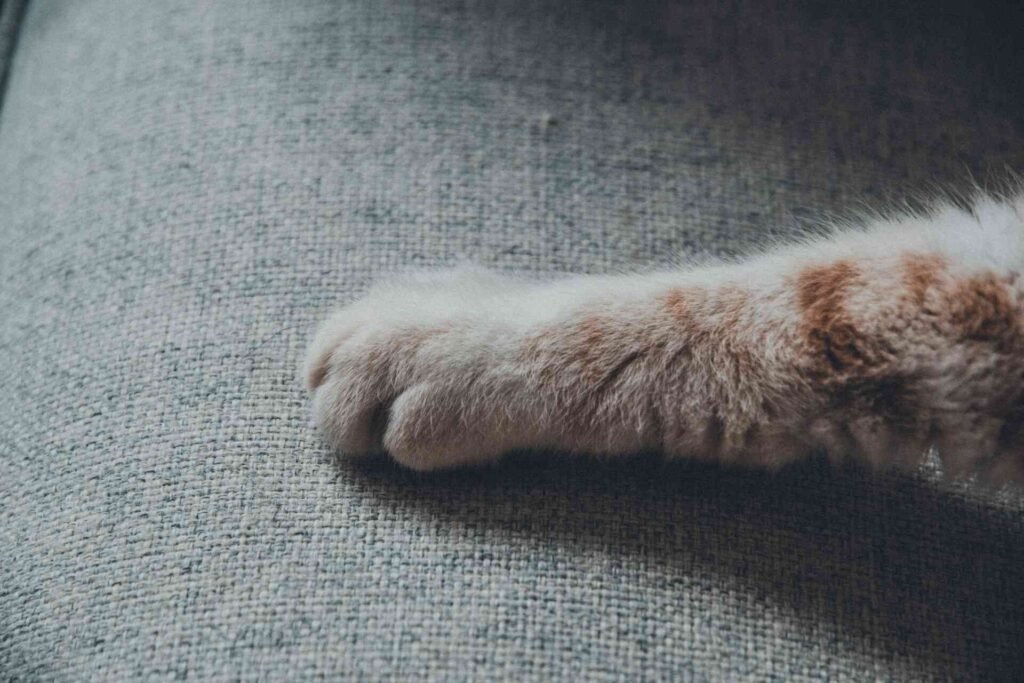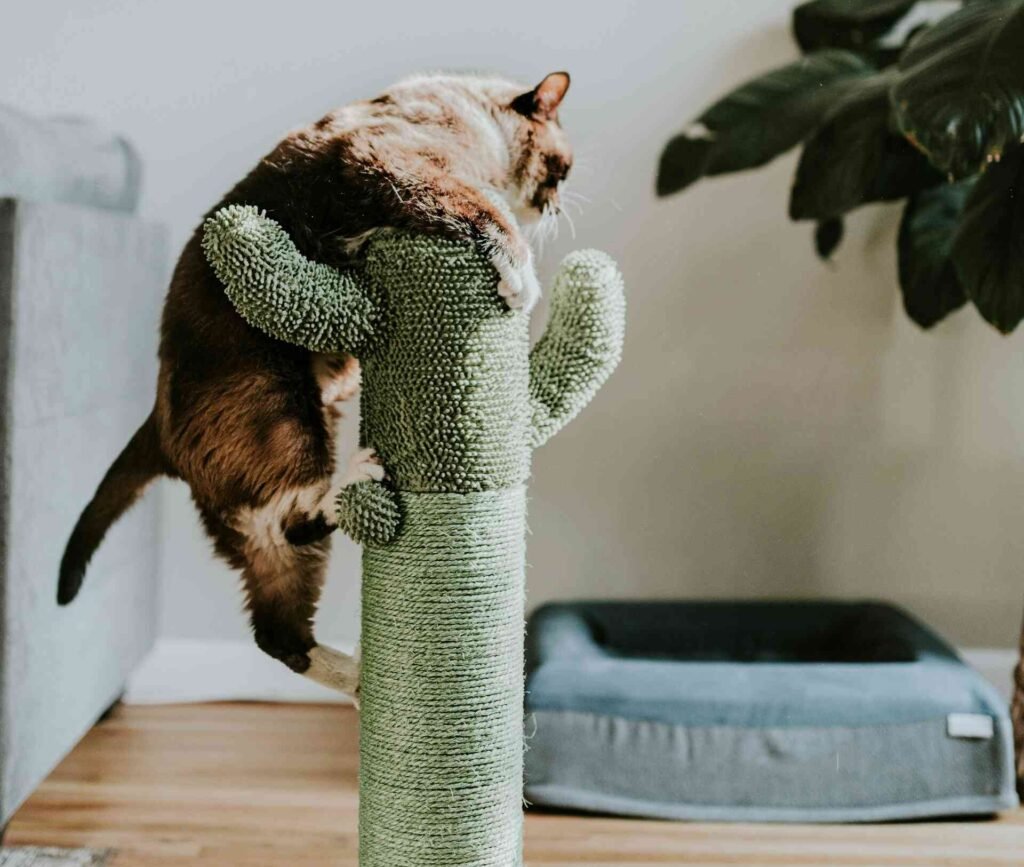Picture this: you’re relaxing after a long day when you hear that familiar sound: your cat’s claws rhythmically working against your beautiful carpet. If your cat is tearing up your carpet, you’re not alone in this frustrating battle. Millions of pet parents face this exact challenge, watching helplessly as their furry friends transform expensive flooring into shredded remnants.
The good news? Understanding why your cat tears up the carpet is the first step toward reclaiming your home’s beautiful floors. This destructive behavior isn’t just random mischief, it’s deeply rooted in natural feline instincts that we can redirect with the right approach.

Why Your Cat Tears Up the Carpet
When we see our cats methodically clawing at carpet fibers, it’s easy to assume they’re being deliberately destructive. However, carpet scratching serves several essential purposes for our feline companions that go far beyond simple mischief.
Cats possess scent glands in their paw pads that release pheromones during scratching sessions. This scent-marking behavior helps them establish territory and communicate with other cats in the household. Your carpet becomes a canvas for these invisible messages, creating a sense of security and ownership for your pet.
Beyond territorial marking, scratching maintains healthy claws by removing dead outer sheaths and keeping nails sharp. Wild cats naturally scratch tree bark and rough surfaces throughout the day, but indoor cats must find suitable alternatives. Unfortunately, carpets often becomes the most appealing option available.
Cat boredom often manifests through destructive behaviors like excessive carpet scratching. Understimulated cats channel their energy into whatever activities capture their attention, and the texture and resistance of carpets can provide the mental engagement they crave.
The location of carpet scratching also tells us important information about motivation. Cats frequently target high-traffic areas where family members spend time, reinforcing social bonds through scent mixing. This explains why many cats focus their attention on living room carpets or bedroom entrances rather than hidden corners.
Common Areas Where Cats Target Carpets
Not all carpet destruction happens randomly throughout the house. Cats typically focus their scratching efforts on specific areas that serve particular purposes in their daily routines and territorial behaviors.
Doorway carpets receive intense attention because they represent transition zones between territories. When cats tear up carpets in front of doors, they’re often marking these important boundaries while also stretching their muscles after periods of rest. The threshold between rooms holds special significance in feline psychology, making these spots prime real estate for scratching behavior.
High-traffic family areas like living rooms and hallways become natural targets because they smell strongly of human activity. Cats enjoy mixing their scent with family odors, creating a communal fragrance that reinforces pack bonding. These social scratching sessions often intensify during periods when families spend more time together.
Bedroom carpets near sleeping areas attract scratching because cats associate these locations with safety and comfort. Morning scratching rituals help cats prepare for the day ahead while leaving familiar scent markers in their favorite resting spots.
Some cats develop preferences for specific carpet textures or colors, leading to concentrated damage in particular rooms. Loop pile carpets often suffer more damage than cut pile varieties because individual loops catch and hold claws, providing satisfying resistance during scratching sessions.
The Real Reasons Behind Carpet Scratching
Moving beyond surface-level observations, several deeper motivations drive persistent carpet scratching behaviors that pet parents need to understand for effective intervention strategies.
Stress and anxiety frequently manifest through increased scratching activity, particularly when cats feel their territory is threatened or their routine has been disrupted. New pets, household changes, or environmental stressors can trigger compensatory scratching as cats attempt to reestablish control over their surroundings.
Medical conditions occasionally contribute to abnormal scratching behaviors. Declawed cats may develop chronic pain that leads to unusual scratching motions, while cats with arthritis might scratch the carpet because vertical scratching posts cause discomfort. Observing your cat’s body language during scratching can reveal whether physical issues are involved.

Inadequate environmental enrichment forces cats to create their own entertainment through whatever means available. Cats require mental stimulation, physical exercise, and appropriate outlets for natural behaviors. When we fail to provide suitable alternatives, carpets becomes the default option for meeting these essential needs.
Some cats develop carpet preferences simply because they’ve learned that this behavior garners attention from their humans. Even negative attention like scolding can reinforce the behavior if cats are seeking interaction and engagement from their families.
Effective Strategies to Stop Carpet Damage
Successfully redirecting your cat’s scratching behavior requires a multi-faceted approach that addresses both the underlying motivations and provides attractive alternatives to carpet destruction.
Providing appropriate scratching surfaces forms the foundation of any successful intervention strategy. Cats need scratching posts that match their preferences for height, stability, and texture. Tall posts allow full-body stretching, while sturdy construction prevents wobbling that might deter use.
Experiment with different scratching surface materials to identify your cat’s preferences. Some cats prefer sisal rope’s rough texture, while others gravitate toward corrugated cardboard or natural wood surfaces. Strategic cat furniture placement can help you position scratching posts in locations that naturally attract your cat’s attention.
Horizontal scratching pads work well for cats who prefer ground-level scratching, especially when placed near problem carpet areas. These alternatives provide similar texture and resistance to a carpet while protecting your flooring investment.
Making carpets less appealing involves both physical deterrents and scent modification. Double-sided tape applied to problem areas creates an unpleasant texture that discourages scratching without harming your pet. Aluminum foil produces similar results while being easily removable when guests visit.
Citrus-scented sprays naturally deter most cats from treated areas, though you’ll need to reapply regularly for continued effectiveness. Commercial deterrent sprays designed specifically for cats often provide longer-lasting protection while being safe for both pets and carpets.
Trimming your cat’s claws becomes crucial for minimizing carpet damage during the transition period. Regular nail trims reduce the destructive potential of scratching sessions while your cat learns to use appropriate alternatives.
Scratching Post Selection and Placement Guide
| Feature | Importance | Recommendations |
|---|---|---|
| Height | Critical | Minimum 32 inches for full stretching |
| Stability | Essential | Weighted base or wall-mounted options |
| Material | High | Sisal rope, corrugated cardboard, or natural bark |
| Location | Critical | Near sleeping areas and problem spots |
| Quantity | Important | One per cat plus one extra |
The most expensive scratching post becomes worthless if your cat won’t use it. Understanding feline psychology helps ensure your investment actually protects your carpet rather than gathering dust in the corner.
Position scratching posts near areas where your cat currently scratches carpets, gradually moving them to more convenient locations once your pet develops consistent usage habits. Cats often scratch immediately after waking up, so placing posts near sleeping areas encourages natural behavior redirection.
Multiple scratching options throughout your home prevent your cat from defaulting to the carpet when their preferred post isn’t conveniently accessible.

Never force your cat to use scratching posts through physical manipulation, as this creates negative associations that discourage future use. Instead, make posts appealing through catnip application, interactive play sessions nearby, and positive reinforcement when you observe appropriate scratching behavior.
Environmental Modifications That Work
Creating an environment that naturally discourages carpet scratching while providing appropriate alternatives requires thoughtful consideration of your cat’s daily routines and preferences.
Carpet protection strategies range from temporary solutions during training periods to permanent modifications that prevent future damage. Area rugs placed over problem spots provide a removable barrier that’s easier to replace than wall-to-wall carpeting.
Furniture rearrangement can eliminate access to favorite scratching locations while directing your cat toward appropriate alternatives. Strategically placed scratching posts become more attractive when they’re the most convenient option available.
Enrichment additions address the underlying boredom and stress factors that contribute to destructive scratching. Interactive toys, puzzle feeders, and regular play sessions provide mental stimulation that reduces the likelihood of carpet destruction. Cats with adequate enrichment spend less time seeking alternative entertainment through destructive behaviors.
Cats meowing at night can connect to the same underlying issues that drive daytime carpet scratching. Addressing sleep disruptions and anxiety can simultaneously improve multiple behavioral concerns.
Vertical space additions like cat trees and wall-mounted shelves provide alternative territories that reduce territorial scratching in carpet areas. Cats prefer elevated vantage points that offer security and observation opportunities.
Training Techniques and Positive Reinforcement
Successful behavior modification relies on patience, consistency, and understanding of feline learning patterns rather than punishment-based approaches that often backfire with cats.
Positive reinforcement strategies focus on rewarding desired behaviors rather than punishing unwanted ones. When you catch your cat using appropriate scratching surfaces, immediately offer treats, praise, or interactive play to reinforce the behavior.
Timing becomes crucial for effective reinforcement. Cats connect rewards with their most recent actions, so delayed responses lose their training value. Keep treats readily available near scratching posts to ensure immediate positive feedback when appropriate behavior occurs.
Redirection techniques help transition your cat from carpet to appropriate surfaces without creating stress or conflict. When you notice carpet scratching beginning, calmly guide your cat to a nearby scratching post and encourage its use through gentle interaction or toy engagement.
Never use spray bottles, loud noises, or physical punishment to discourage carpet scratching. These methods create anxiety and fear without addressing underlying motivations, often leading to increased behavioral problems and damage to your relationship with your cat.
Consistency among all family members ensures your cat receives clear, unified messages about appropriate behavior. Mixed signals from different household members confuse cats and slow training progress significantly.
When to Seek Professional Help
Some carpet scratching situations require expert intervention beyond standard home training techniques, particularly when underlying medical or psychological issues contribute to the behavior.
Veterinary consultation becomes necessary when scratching behavior suddenly increases, changes in character, or accompanies other symptoms like appetite changes, litter box issues, or unusual aggression. Medical conditions can drive behavioral changes that appear purely behavioral on the surface.
Some situations benefit from temporary pharmaceutical intervention to reduce anxiety levels while implementing behavioral modifications. Your veterinarian can determine whether anti-anxiety medications might help during the training process.
Preventing Future Carpet Damage
Long-term success requires ongoing attention to your cat’s environmental needs and behavioral patterns rather than viewing scratching post installation as a one-time solution.

Maintenance strategies include regular scratching post replacement, environmental enrichment updates, and continued positive reinforcement of appropriate behaviors. Even well-trained cats can revert to carpet scratching if their approved alternatives become worn or unappealing.
Monitor your cat’s scratching patterns for changes that might indicate new stressors or environmental factors requiring attention. Our article on why cats keep knocking over water bowls demonstrates how seemingly unrelated behaviors often connect to broader environmental or health issues.
Regular claw trimming, environmental enrichment updates, and health monitoring form the foundation of long-term carpet protection. These proactive measures prevent problems from developing rather than requiring reactive solutions after damage occurs.
Frequently Asked Questions
Why does my cat keep tearing up the carpet even with scratching posts available?
Cats may continue carpet scratching despite having scratching posts if the posts don’t meet their preferences for height, stability, texture, or location. Additionally, established habits require time and patience to change. Try different post materials, ensure posts are tall and stable enough, and place them near current carpet scratching locations.
How long does it take to stop a cat from tearing up a carpet?
The timeline varies significantly based on your cat’s age, personality, and how long the behavior has been established. Most cats show improvement within 2-4 weeks of consistent training, but complete behavior change may take 2-3 months. Older cats and those with deeply ingrained habits typically require longer adjustment periods.
Can I use carpet remnants to make scratching surfaces?
While carpet remnants might seem logical, they can actually confuse your cat about which carpeted surfaces are appropriate for scratching. Stick to distinctly different textures like sisal, corrugated cardboard, or natural wood to help your cat clearly distinguish between scratching posts and household carpets.
What should I do if my cat tears up the carpet under doors?
Carpet scratching under doors often indicates anxiety about territorial boundaries or desire to access restricted areas. Address the underlying cause by providing environmental enrichment, ensuring adequate social interaction, and potentially allowing supervised access to previously restricted spaces when safe and appropriate.
Is it normal for cats to scratch the carpet more during certain times of day?
Yes, many cats exhibit increased scratching activity during dawn and dusk periods when their natural hunting instincts are most active. Morning scratching sessions often occur immediately after waking up as cats stretch and prepare for daily activities. Providing engaging alternatives during these peak periods can reduce carpet damage.
Conclusion
Successfully stopping your cat from tearing up the carpet requires understanding the natural instincts behind this behavior while providing appealing alternatives that meet your pet’s physical and psychological needs. Remember that patience and consistency are key, most cats need several weeks to fully transition from carpet to appropriate scratching surfaces.
The combination of proper scratching post selection, strategic placement, environmental modifications, and positive reinforcement creates the best chance for long-term success. When you address both the underlying motivations and provide suitable outlets for natural scratching behaviors, you can protect your beautiful carpets while keeping your feline friend happy and healthy.
Every cat responds differently to various strategies, so don’t get discouraged if the first approach doesn’t immediately solve the problem. With persistence and the right techniques, you can reclaim your carpets and strengthen the bond with your beloved pet through positive, understanding-based training methods.
Looking for more? Explore our Cat Furniture section for more posts like this, visit the Blog for fun and insightful reads, or browse our full Cat Category for everything feline-related, from care to comfort.
Disclaimer: This article is for informational purposes only and does not substitute for professional veterinary advice. Always consult your veterinarian for diagnosis and treatment tailored to your cat’s individual needs. Please verify current product information directly on the retailer’s site before purchasing.
References
- Debra Horwitz, DVM, DACVB & Gary Landsberg (2016). Cat Behavior Problems – Scratching Behavior. https://vcahospitals.com/know-your-pet/cat-behavior-problems—scratching-behavior
- Feline Behavior Problems: Destructive Behavior (2018). https://www.vet.cornell.edu/departments-centers-and-institutes/cornell-feline-health-center/health-information/feline-health-topics/feline-behavior-problems-destructive-behavior
- What is padding and why do cats do it? (2021). https://themayhew.org/what-is-padding/
Check out our most recent articles!
- Cats and Snow: Why Some Love It and Others Don’tSnow isn’t just uncomfortable for many cats, it’s a complete sensory overload. From cold paw pads to wet fur and changed landscapes, winter challenges feline comfort in unexpected ways. Learn how to recognize stress signals and create cozy alternatives for snow-averse cats.
- Christmas Names for Cats: From Classic to Creative Holiday IdeasNaming your holiday cat goes beyond festive fun. Discover why Christmas-inspired names age beautifully, spark instant connections with fellow pet lovers, and capture the warmth cats bring to our homes during the most magical season of the year.
- How to Keep Your Cat From Drinking Christmas Tree WaterYour cat’s obsession with Christmas tree water isn’t just annoying, it’s genuinely dangerous. From harmful bacteria to toxic additives, that festive reservoir poses real health risks. Discover practical solutions that protect your pet without sacrificing holiday cheer.
- Best Cat Toys for Christmas: The Ultimate Guide to Holiday JoyNot all Christmas gifts end up under the tree, some get batted across the floor at 3 AM. Explore the wonderful world of holiday cat toys that match your feline’s personality, from plush companions for cuddlers to high-tech options for the eternally energetic.
- Are Fake Christmas Trees Safe for Cats? A Holiday Safety GuideThat beautiful Christmas tree might look festive to you, but to your cat, it’s an irresistible climbing gym with built-in toys. Find out whether artificial trees are truly safer for cats and discover the hidden dangers lurking in your holiday decorations.
- The Best Christmas Gifts for Cats That’ll Actually Get Used (Not Ignored)Not all Christmas gifts land on the nice list with our feline friends. Discover which presents actually spark joy in cats and which ones end up gathering dust under the couch by New Year’s Day.
- Do Cats Eat Less in Winter? How Cold Weather Affects Your Cat’s AppetiteWinter brings more than just cold weather, it can completely change your cat’s eating habits. From bored indoor cats to outdoor ferals fighting to survive, discover what’s really driving those appetite changes and how to respond appropriately.
- Are Humidifiers Good for Cats? A Complete Safety & Health GuideNot all humidifiers are cat-safe, and some common practices could be toxic. Learn why cool mist beats warm mist, why essential oils are dangerous for felines, and how proper humidity levels between 30-50% support your cat’s breathing and coat health.
- How to Protect Leather Furniture From Cats (Without Losing Your Mind)Leather furniture and cat claws seem like natural enemies, but they don’t have to be. Learn why your cat is drawn to that expensive couch in the first place, and how simple redirects can save your furniture while keeping your cat’s natural behaviors satisfied.
- The Best Material for Cat Bowls: Protect Your Cat from BacteriaStainless steel, ceramic, or plastic, which material keeps your cat healthiest? We break down the science behind cat bowl materials, revealing why some harbor bacteria and others last decades without compromising your feline’s wellbeing.










